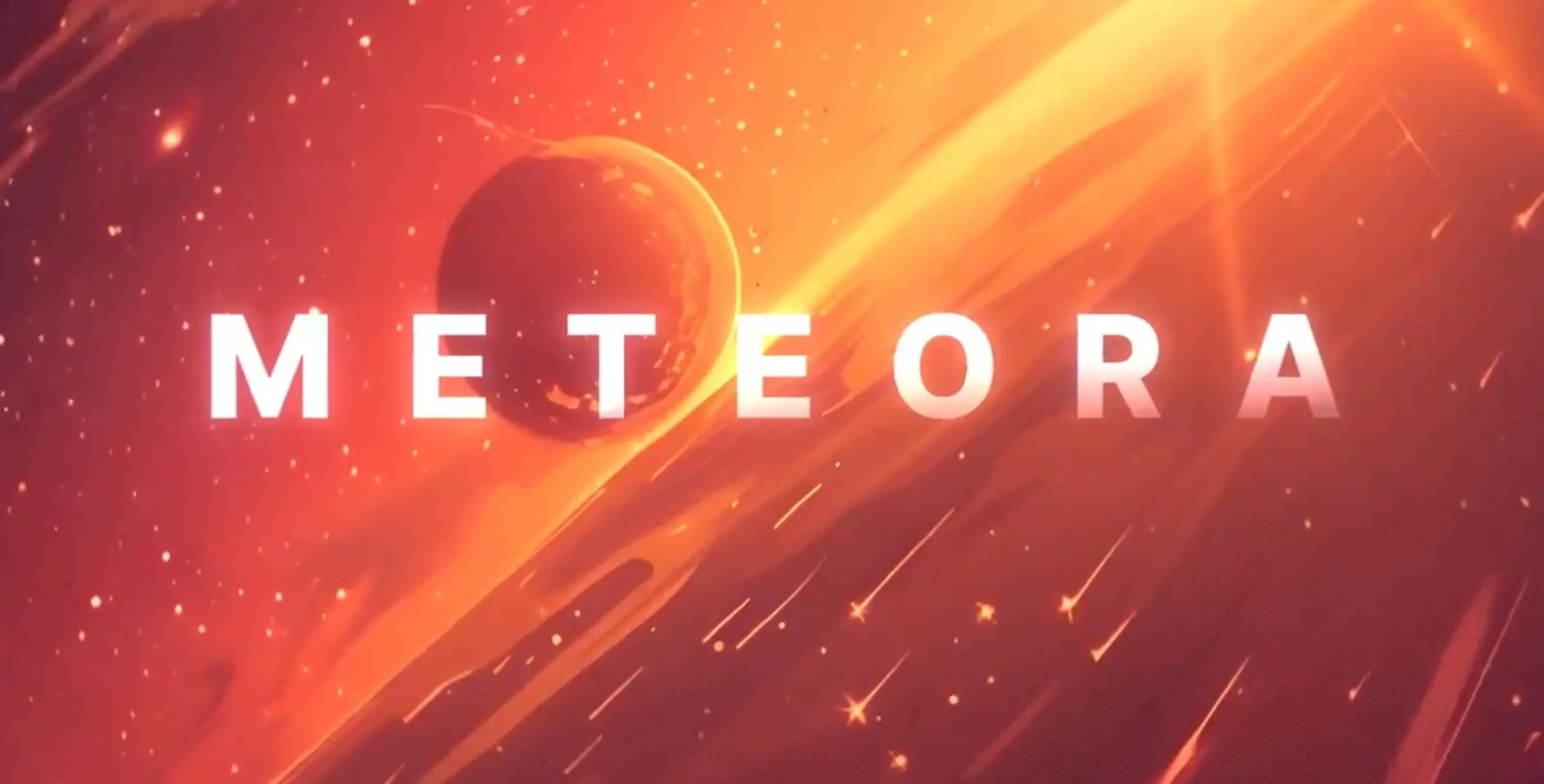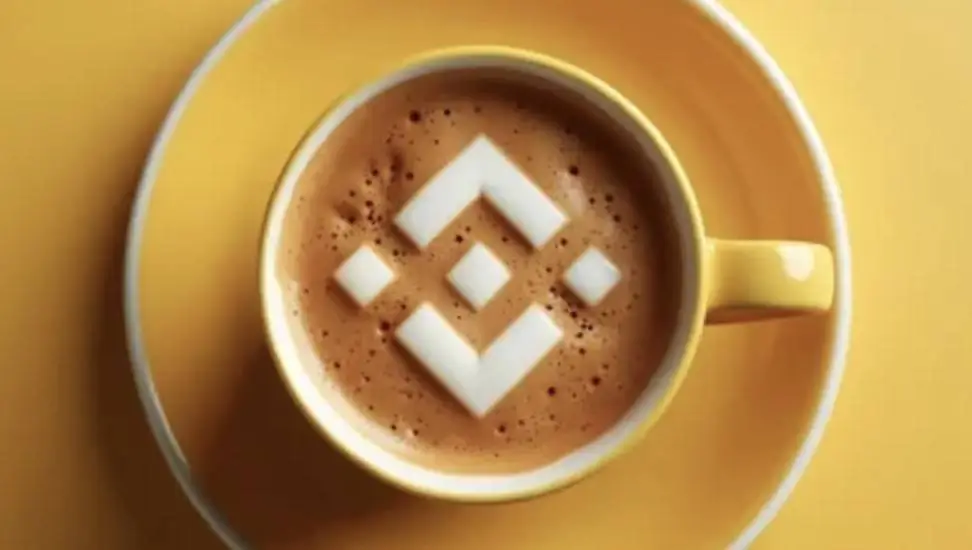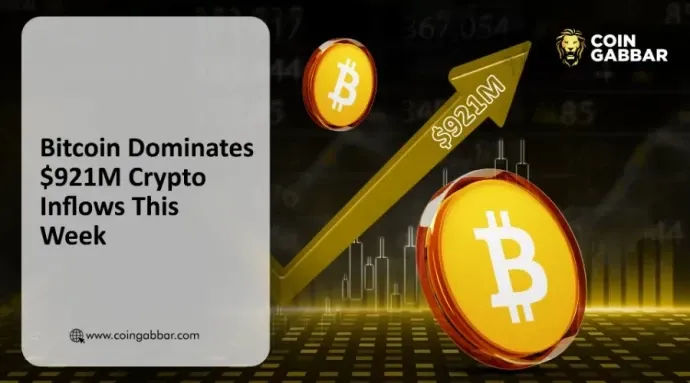Bitcoin relies on algorithmic consensus to achieve "decentralization of trust," while tokenized gold depends on institutional credit, belonging to a "re-trust" model.
Have you noticed that more and more people around you are discussing "gold"?
Yes, I am referring to gold in its physical sense. With the increase in geopolitical risks and global macroeconomic uncertainties, the total market value of gold (at one point) reached $30 trillion, firmly securing its position as the top global asset.
At the same time, something quite interesting is happening in the Crypto world. Beyond Bitcoin, which is widely regarded as "digital gold," physical gold is accelerating its on-chain transformation: tokenized gold, represented by Tether Gold (XAUT), has gained new capabilities such as being divisible, programmable, and even yield-bearing through the RWA wave.
It is challenging a narrative that has long been monopolized by Bitcoin: "Who is the true digital gold?"
01. BTC: The Evolution of Narrative Over a Decade
Is BTC a currency or an asset? Is its core function payment or value storage? Or is it a risk asset similar to tech stocks?
Since its inception in 2009, this question has permeated nearly every stage of Bitcoin's history.
Although Satoshi Nakamoto clearly stated BTC's "Electronic Cash" attribute in the white paper, the evolution of its scale over the past decade has led to a narrative that has undergone numerous reversals and community debates—ranging from an early payment method to "value storage" and "alternative asset."
Especially with the formal approval of the spot ETF in 2024, it has become a turning point in the narrative. More people no longer see Bitcoin as a "global currency" for trading and payments; instead, an increasing number of individuals view Bitcoin as a value storage asset with a consensus foundation, also known as "digital gold":
Like gold, it is scarce in total supply, with predictable and stable production, but it also possesses advantages that gold cannot match: better divisibility (1 satoshi = 0.00000001 BTC), portability (instant cross-border transfers), and liquidity (24/7 market).
As a result, Bitcoin is gradually becoming the third global store of value logic after the US dollar and gold in the macro monetary system.
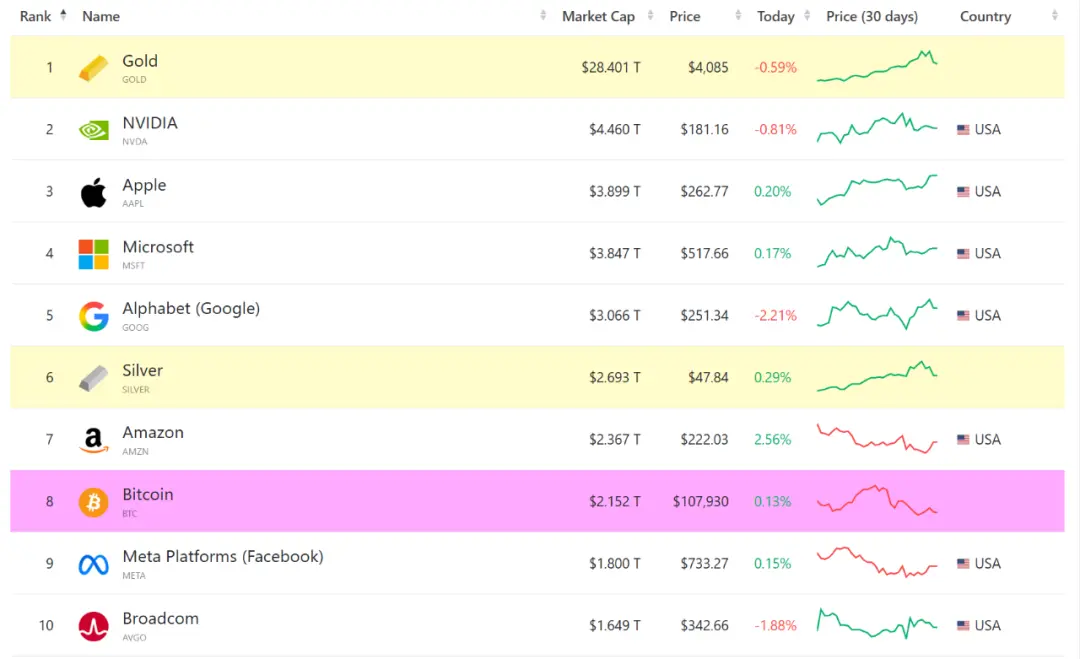
Source: companiesmarketcap.com
According to statistics from companiesmarketcap, gold is in an absolute leading position among the top 10 assets globally, with a total market value of $28.4 trillion, far exceeding the combined total of the next nine assets ($26 trillion).
It is worth noting that even when BTC surpassed $100,000, its total market value was only $2 trillion, which is merely about 1/15 of gold's total market value. This is precisely the underlying motivation for the BTC community to continuously emphasize the "digital gold" narrative, targeting the largest and oldest value storage asset in the traditional financial world.
Interestingly, while BTC strives to align with the "digital gold" narrative, gold itself is also being "digitized."
The most direct incentive is the continuous new highs in real-world gold prices and the RWA wave this year, which has led to the rapid rise of tokenized gold represented by Tether Gold (XAUT) and PAX Gold (PAXG).
Since they are anchored to physical gold, each token issued is backed by an equivalent amount of physical gold reserves, making these "digital gold" products a new financial species in both the Crypto and TradFi realms.
02. The "Emerging" RWA Wave of Gold
In fact, using the term "emerging" for tokenized gold may not be entirely accurate.
Because, strictly speaking, whether it is the currently largest XAUT or the closely following PAXG, neither is a newly launched trendy product. Instead, it is the current RWA wave and macro market conditions that have given them new strategic significance and market attention.
Taking XAUT as an example, its early development can be traced back to the end of 2019. At that time, Bitfinex and Tether's Chief Technology Officer Paolo Ardoino revealed that Tether was planning to launch a gold-backed stablecoin product, Tether Gold, and the XAUT white paper was published on January 28, 2022.
The white paper clearly states that each XAUT token represents ownership of one ounce of physical gold, and Tether guarantees that it has prepared a corresponding amount of physical gold reserves for issuance, all stored in "first-class secure Swiss vaults."
As of the time of writing, the total issuance of XAUT has exceeded $1.55 billion, representing approximately 966 gold bars (totaling 11,693.4 kilograms).
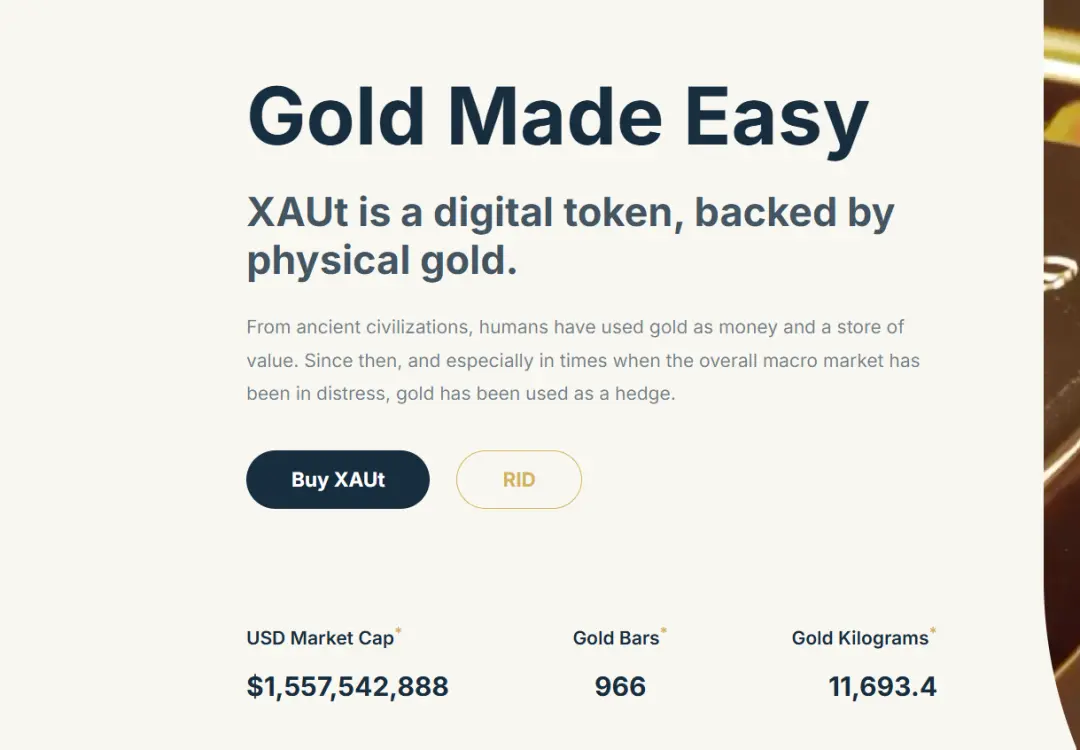
Source: Tether
In fact, in Tether Gold's white paper, we can see its clear positioning of advantages:
Compared to physical gold, "gold stablecoins" can break down the difficult-to-divide precious metal into smaller denominations, making it easier to carry and transport, significantly lowering the investment threshold for individuals;
Compared to gold ETFs, it enables 24/7 trading of assets without custody fees, greatly improving the speed and efficiency of asset transfers;
In other words, Tether Gold believes it can help users obtain high liquidity and divisibility while owning gold anchored behind it.
In other words, tokenization has given real gold the unique "digital attributes" of BTC, allowing it to be fully absorbed into the digital world for the first time, becoming an asset unit that can flow, combine, and be calculated freely. This step has transformed products like XAUT from merely being "on-chain gold certificates" to opening up vast on-chain possibilities.
Of course, this trend also prompts the market to reconsider: when both gold and BTC become on-chain assets, is their relationship one of competition or symbiosis?
03. The Reflection on Tokenized Gold and Digital Gold
Overall, if BTC's core narrative is "scarce consensus in the digital world," then the biggest difference of tokenized gold (XAUT/PAXG) lies in "bringing scarce consensus into the digital world."
This is a subtle yet essential difference, where BTC creates trust entirely from scratch, while tokenized gold digitizes the traditional trust structure. As CZ recently tweeted:
"Tokenized gold is not truly on-chain gold; it is based on trust in the issuer's ability to fulfill its obligations. Even in extreme situations, such as management changes or wars, users still need to rely on the continuation of this trust system."
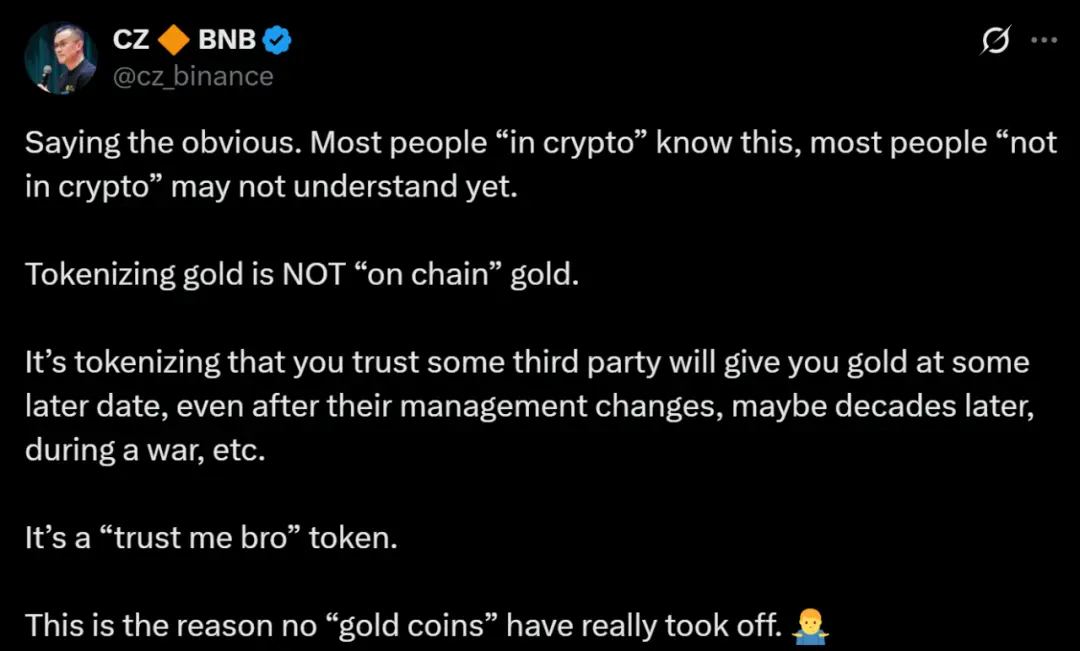
This statement highlights the fundamental difference between tokenized gold and Bitcoin: Bitcoin's trust is algorithmic consensus, with no issuing party or custodial institution, while tokenized gold's trust is institutional credit—requiring belief that Tether or Paxos will strictly adhere to their reserve commitments.
This also means that Bitcoin is a product of "decentralization of trust," while tokenized gold is an extension of "re-trust."
Of course, if we only look at the added value from the asset perspective, in the traditional financial system, gold's core value lies in hedging and preservation of value. However, in the blockchain context, tokenized gold has for the first time gained programmability:
It can be used as collateral in DeFi protocols, borrowing stablecoins on platforms like Aave and Compound for leverage or yield management;
It can be integrated into smart contract logic, becoming yield-bearing gold, with the potential to generate income;
It can also flow freely across different networks through cross-chain bridges, becoming a stable liquid asset in a multi-chain ecosystem;
The essence of this change is that gold has transformed from a static store of value into a dynamic financial unit, endowing gold with Bitcoin-like digital attributes through tokenization—verifiable, liquid, combinable, and computable. This means that gold is no longer just a symbol of value lying in vaults but has become a "living asset" in the on-chain world that can participate in yields and generate credit.
Objectively speaking, in the current context of tightening liquidity and weak alt assets, the rise of the RWA wave has brought traditional assets like gold, bonds, and stocks back into the crypto spotlight. The popularity of tokenized gold precisely indicates that the market is seeking a more robust and certain on-chain value anchor.
From this perspective, the rapidly developing tokenized gold under the RWA wave is not meant to (and cannot) replace BTC, but rather serves as a perfect complement to BTC's "digital gold" narrative, becoming a new financial species that combines the efficient liquidity of digital assets with the hedging certainty of traditional gold.
免责声明:本文章仅代表作者个人观点,不代表本平台的立场和观点。本文章仅供信息分享,不构成对任何人的任何投资建议。用户与作者之间的任何争议,与本平台无关。如网页中刊载的文章或图片涉及侵权,请提供相关的权利证明和身份证明发送邮件到support@aicoin.com,本平台相关工作人员将会进行核查。
